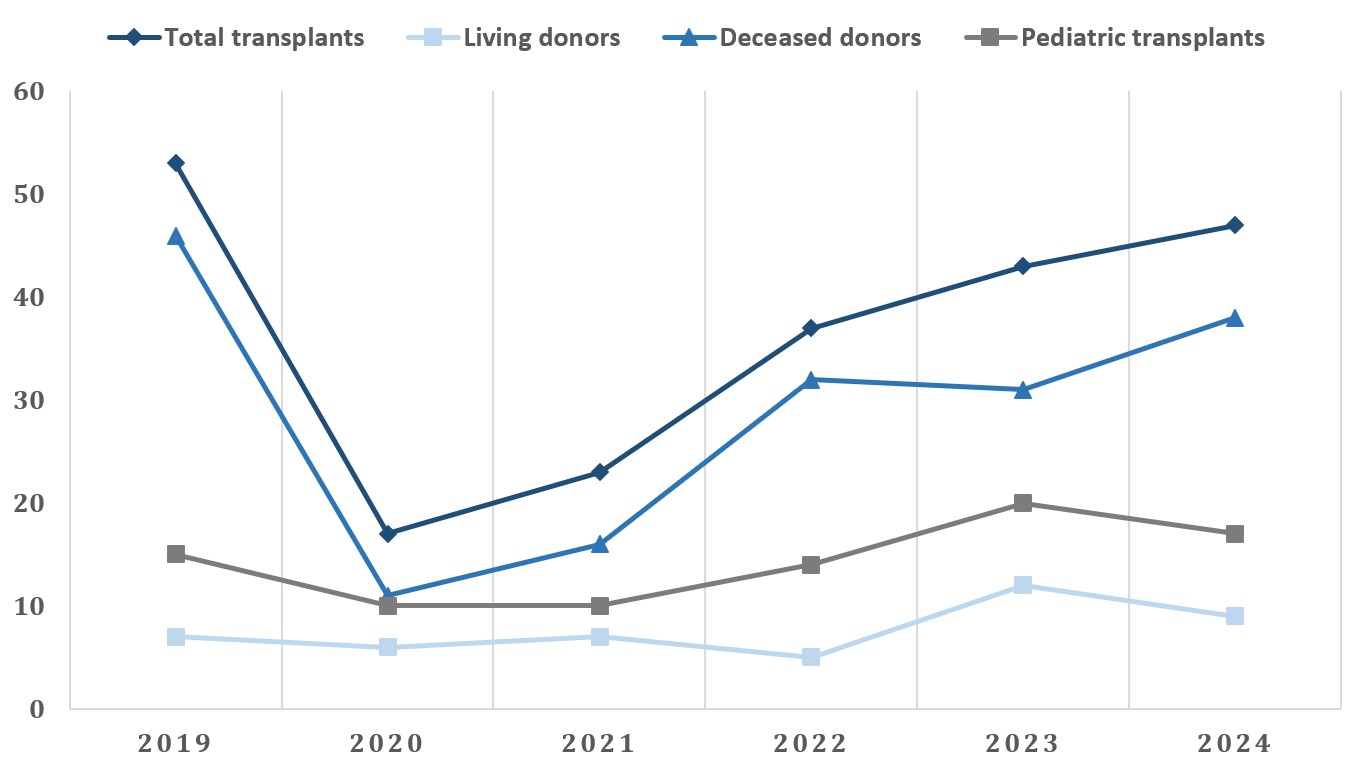Monday Poster Session
Category: Liver
P3793 - Trends in Liver Transplantation in Peru: A Five-Year National Analysis (2019–2024)
Monday, October 27, 2025
10:30 AM - 4:00 PM PDT
Location: Exhibit Hall

David Guevara-Lazo, MD (he/him/his)
University of Michigan
Ann Arbor, MI
Presenting Author(s)
David Guevara-Lazo, MD1, Natalia R. Nombera Aznaran, MD2, Roxana M. Aznaran-Torres, MD, PhD3, Renzo S. Zeballos Gonzalez, 4, Jorge Garavito Renteria, MD5
1University of Michigan, Ann Arbor, MI; 2University of Alabama at Birmingham, Birmingham, AL; 3Escuela de Posgrado, Universidad Privada Antenor Orrego, Trujillo, La Libertad, Peru; 4Universidad Peruana Cayetano Heredia, Lima, Lima, Peru; 5Liver Unit, Department of Gastroenterology, Hospital Nacional Arzobispo Loayza, Lima, Lima, Peru
Introduction: In recent years, liver diseases have increasingly burdened healthcare systems across Latin America. Liver transplantation (LT) remains the only curative option for patients with decompensated cirrhosis and acute liver failure. However, in Peru, the development of LT programs faces significant structural challenges, including low organ donation rates, a fragmented healthcare system, and limited access to specialized care. This study examines national trends in liver transplantation in Peru between 2019 and 2024.
Methods: We conducted a descriptive analysis of LT in Peru using national registry data from 2019 to 2024. Trends were stratified by donor type (living vs. deceased) and age group (adult vs. pediatric). Transplant rates per million population (pmp) were standardized with World Bank data. Recipient characteristics (age, sex, and healthcare institution type) were also analyzed.
Results: Following a sharp decline during the COVID-19 pandemic, LT rates in Peru showed a progressive recovery. In 2019, the national LT rate was 1.63 transplants pmp, dropping to 0.52 pmp in 2020 and remaining low in 2021 (0.69 pmp). From 2022 onward, a sustained recovery was observed, reaching 1.11 pmp in 2022, 1.27 in 2023, and 1.38 in 2024. Deceased donor LTs accounted for the majority of procedures throughout the study period (79%). In contrast, living donor LTs represented 21% of total LTs, with consistently low annual rates. The mean age of transplant recipients was 34.2 years (±25.0), ranging from infants under one year to elderly adults. Males accounted for 55% of all recipients, and 99.5% of procedures were performed in Lima. Pediatric LT remained consistently low, ranging from 10 to 20 procedures annually, with a cumulative total of 86 cases. All LTs were conducted in Lima, except for one performed in Junin. Institutionally, EsSalud conducted the majority of procedures, performing 92.7% of all LTs, while MINSA, accounted for 7.3%, all in pediatric patients.
Discussion: Liver transplantation in Peru has shown steady recovery following the impact of the pandemic, yet structural barriers continue to hinder its development. The concentration of procedures in Lima and within the social security system reflects significant inequities in access. These findings underscore the need for public policies aimed at strengthening organ donation, decentralizing transplant services, and expanding pediatric coverage, in pursuit of a more equitable and sustainable transplant system.

Figure: Figure 1. Absolute number of liver transplants performed in Peru, 2019–2024
Disclosures:
David Guevara-Lazo indicated no relevant financial relationships.
Natalia Nombera Aznaran indicated no relevant financial relationships.
Roxana Aznaran-Torres indicated no relevant financial relationships.
Renzo Zeballos Gonzalez indicated no relevant financial relationships.
Jorge Garavito Renteria indicated no relevant financial relationships.
David Guevara-Lazo, MD1, Natalia R. Nombera Aznaran, MD2, Roxana M. Aznaran-Torres, MD, PhD3, Renzo S. Zeballos Gonzalez, 4, Jorge Garavito Renteria, MD5. P3793 - Trends in Liver Transplantation in Peru: A Five-Year National Analysis (2019–2024), ACG 2025 Annual Scientific Meeting Abstracts. Phoenix, AZ: American College of Gastroenterology.
1University of Michigan, Ann Arbor, MI; 2University of Alabama at Birmingham, Birmingham, AL; 3Escuela de Posgrado, Universidad Privada Antenor Orrego, Trujillo, La Libertad, Peru; 4Universidad Peruana Cayetano Heredia, Lima, Lima, Peru; 5Liver Unit, Department of Gastroenterology, Hospital Nacional Arzobispo Loayza, Lima, Lima, Peru
Introduction: In recent years, liver diseases have increasingly burdened healthcare systems across Latin America. Liver transplantation (LT) remains the only curative option for patients with decompensated cirrhosis and acute liver failure. However, in Peru, the development of LT programs faces significant structural challenges, including low organ donation rates, a fragmented healthcare system, and limited access to specialized care. This study examines national trends in liver transplantation in Peru between 2019 and 2024.
Methods: We conducted a descriptive analysis of LT in Peru using national registry data from 2019 to 2024. Trends were stratified by donor type (living vs. deceased) and age group (adult vs. pediatric). Transplant rates per million population (pmp) were standardized with World Bank data. Recipient characteristics (age, sex, and healthcare institution type) were also analyzed.
Results: Following a sharp decline during the COVID-19 pandemic, LT rates in Peru showed a progressive recovery. In 2019, the national LT rate was 1.63 transplants pmp, dropping to 0.52 pmp in 2020 and remaining low in 2021 (0.69 pmp). From 2022 onward, a sustained recovery was observed, reaching 1.11 pmp in 2022, 1.27 in 2023, and 1.38 in 2024. Deceased donor LTs accounted for the majority of procedures throughout the study period (79%). In contrast, living donor LTs represented 21% of total LTs, with consistently low annual rates. The mean age of transplant recipients was 34.2 years (±25.0), ranging from infants under one year to elderly adults. Males accounted for 55% of all recipients, and 99.5% of procedures were performed in Lima. Pediatric LT remained consistently low, ranging from 10 to 20 procedures annually, with a cumulative total of 86 cases. All LTs were conducted in Lima, except for one performed in Junin. Institutionally, EsSalud conducted the majority of procedures, performing 92.7% of all LTs, while MINSA, accounted for 7.3%, all in pediatric patients.
Discussion: Liver transplantation in Peru has shown steady recovery following the impact of the pandemic, yet structural barriers continue to hinder its development. The concentration of procedures in Lima and within the social security system reflects significant inequities in access. These findings underscore the need for public policies aimed at strengthening organ donation, decentralizing transplant services, and expanding pediatric coverage, in pursuit of a more equitable and sustainable transplant system.

Figure: Figure 1. Absolute number of liver transplants performed in Peru, 2019–2024
Disclosures:
David Guevara-Lazo indicated no relevant financial relationships.
Natalia Nombera Aznaran indicated no relevant financial relationships.
Roxana Aznaran-Torres indicated no relevant financial relationships.
Renzo Zeballos Gonzalez indicated no relevant financial relationships.
Jorge Garavito Renteria indicated no relevant financial relationships.
David Guevara-Lazo, MD1, Natalia R. Nombera Aznaran, MD2, Roxana M. Aznaran-Torres, MD, PhD3, Renzo S. Zeballos Gonzalez, 4, Jorge Garavito Renteria, MD5. P3793 - Trends in Liver Transplantation in Peru: A Five-Year National Analysis (2019–2024), ACG 2025 Annual Scientific Meeting Abstracts. Phoenix, AZ: American College of Gastroenterology.
